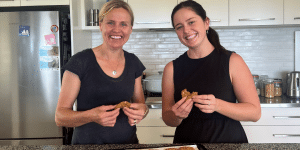The Ultimate Guide to Shoulder Dislocations

What is a shoulder dislocation?
A shoulder dislocation occurs when the ball of your upper arm bone (head of humerus) is forced fully out of its normal position in the shoulder ‘socket’ (the glenoid). A first-time shoulder dislocation is usually associated with extreme pain and an inability to move your arm until it is relocated back into the socket. More than 95% of dislocations are ‘anterior’ meaning the ball dislocates at the front of the socket, such as the clearly deformed shoulder shown with an arrow in the image below.

Shoulder subluxation is a partial shoulder dislocation, when the humeral head moves part way out of the glenoid before relocating spontaneously. It’s a painful injury but not in the same league as a dislocation.
Understanding the shoulder
The shoulder joint has the greatest range of motion of any joint in the body. However, the range of movement comes at a cost to its stability, making it the most dislocated joint in the body. In contrast to many other joints whose stability is dictated by a close fit of opposing bony surfaces, shoulder stability relies on soft-tissue restraints including the joint capsule, labrum (cartilage), ligaments, and muscles. The bones of the shoulder consist of the humerus (the upper arm bone), the scapula (the shoulder blade), and the clavicle (the collar bone).

The head of the humerus fits into a shallow socket on the scapula called the glenoid. This mismatch in diameter allows for a wide range of movement.
Related Reading: Acromioclavicular (AC) Joint Injuries: What you need to know
Common causes of shoulder dislocation
1. Traumatic Shoulder Dislocation
Traumatic shoulder dislocation occurs when your shoulder is in a vulnerable position (to the side or overhead) ‘pops out’ as a result of sudden, high force. Typically this occurs from a fall or a football tackle.
2. Atraumatic Shoulder Dislocation
People with a history of dislocations or particularly lax ligaments can occasionally dislocate their shoulder with very innocuous activity – even something as simple as rolling over in bed! Sports requiring repetitive high load overhead movement such as swimming, tennis, throwing sports (cricket, baseball, javelin), and volleyball can overstretch your shoulder ligaments and joint capsule. Within this group there is a small proportion of patients with Multi-Directional Instability who suffer subluxation or dislocations both anteriorly AND in other planes of movement.
How to treat a shoulder dislocation
- PHASE I: Joint reduction, check neurovascular integrity
The most urgent matter for a recently dislocated shoulder is to ensure the nerves and blood vessels around the joint have escaped injury. If your shoulder didn’t spontaneously relocate, it’s important to attend the ED for an emergency x-ray to exclude fracture. You will then have your shoulder reduced to its normal position by the emergency doctors and re-xrayed to confirm joint alignment.
- PHASE II: Pain relief, minimise swelling, ensure injury protection
Pain will accompany shoulder movement in the early days. Overstretching the injured tissues should be avoided for 2-6 weeks. You will be provided with a shoulder sling for pain relief and joint support. Your physiotherapist will use an array of treatment tools to reduce your pain and inflammation. These may include ice, pain-free exercises, acupuncture/dry needling, taping, and soft tissue massage.
- PHASE III: Maintain and restore muscle control and strength
It’s important to maintain the strength of your shoulder’s rotator cuff muscles and scapular (shoulder blade) stabilisers. The rotator cuff group of muscles work in a coordinated fashion to dynamically stabilise the shoulder joint. Your physio will assess your muscle recruitment pattern and prescribe exercises specific to your needs.
- PHASE IV: Restoring normal movement and posture
As your pain and inflammation settles and the torn ligaments start to heal, your physiotherapist will turn the focus of your treatment program to restoring your normal joint range of motion, muscle length, neural tissue mobility and resting muscle tension.
- PHASE V: Restoring full function
During this stage, your rehabilitation is aimed at enabling a safe return to your desired activities. Everyone has different demands for their shoulders that will determine what specific treatment goals you need to achieve. Your physiotherapist will tailor your shoulder rehabilitation to help you achieve your own functional goals.
How long does it take to recover from a shoulder dislocation?
Returning to athletic activities varies depending on severity of initial injury and the demands of the patient’s work or sport, but 6 to 8 weeks after injury is a minimum and three months is probably safer to avoid re dislocation. People returning to sport or physically demanding jobs are often advised to tape or brace their shoulder for additional support.

What is the risk of shoulder dislocation recurring?
Unfortunately, recurrent dislocation is relatively likely, especially in younger patients. The recurrence rate in patients under 25 years old is about 80%, but much less common in older populations who are generally less exposed to high-impact sports. If your shoulder dislocates three times, it will almost always continue to re-dislocate, often with less and less trauma on each occasion. In this instance, surgical stabilisation is the preferred management option, with good outcomes recorded in terms of pain, movement, strength, and return to activity including sport.
If you would like some professional advice please call one of our experienced physiotherapists or book an appointment online.
References
- Youm T, Takemoto R and Kyu-Hong Park B (2014) Acute Management of Shoulder Dislocations, Journal American Academy of Orthopaedic Surgeons, Vol 22,
No.12:761-771 - Robinson CM, Kelly M, Wakefield AE:Redislocation of the shoulder during thefirst six weeks after a primary anterior dislocation: Risk factors and results
of treatment. J Bone Joint Surg Am 2002;84(9):1552-1559.






